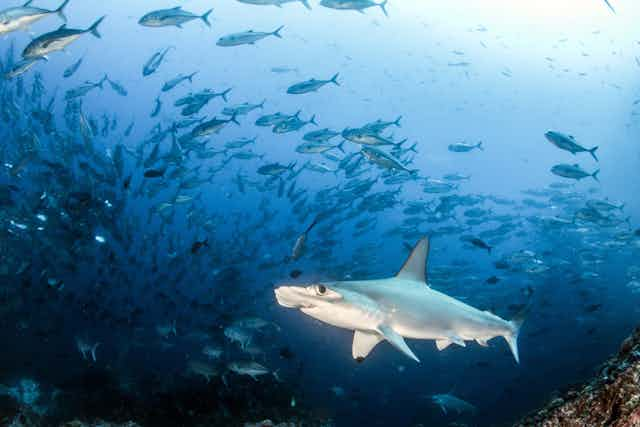Across the globe, sharks have been hit hard by fishing and habitat destruction, which has led to declines in many populations. Marine conservation efforts are increasingly focused on managing particular regions to prevent certain kinds of fishing, or to restore a certain habitat, within their boundaries – things like marine protected areas. So knowing how sharks move around the ocean and use different regions to eat, mate or give birth is particularly important.
In recent years, great advances have been made tracking animals (including sharks) with electronic tags, but it remains very expensive and relatively few animals have been tracked. Not only that, but knowing where a shark is doesn’t necessarily tell you why it is there.
We’re part of a team of 73 scientists from 21 countries who came together to use chemistry to try a different approach to these burning questions. Our study is published in the journal Nature Ecology and Evolution.
We began by looking at plankton. These tiny plants are found at the bottom of marine food webs and, when they are eaten by animals, the chemical make-up of their tissues is passed on. Eventually, the chemical fingerprint first generated by the plants spreads to all other animals in the food web – including sharks.
What we’re interested in is the relative amount of two different carbon isotopes in plankton cells (isotopes are atoms of the same element with slightly different weights). This measurement is useful to us because plankton have different carbon isotope contents across the globe – almost like a chemical post code.

By comparing the carbon isotope post codes in sharks, to maps showing how the isotopes vary in plankton at the bottom of the food chain, we could test whether sharks had been feeding in the same areas in which they were caught. If the post codes matched we could say sharks likely fed where they were caught. If they differed, this may have been due to feeding in different post codes or on different types of food.
5,000 sharks
Our team gathered isotope data on more than 5,000 sharks from 114 species, providing information on a global scale and including more than a fifth of all known shark species. We found that sharks who live in waters close to the coast, such as the great white or reef sharks, had indeed likely been feeding close to where they were caught.

Not only that, but we found that within a population, individual sharks specialised on food from different food webs – either eating entirely different species, or the same species but in slightly different habitats with different plants at the base of the food chain. Sharks possibly do this to reduce competition among themselves.
Shark species that occur in the open ocean, however, such as blue or mako sharks, appeared to get most of their food from a specific isotopic post code, no matter where in the world they were caught. Cooler bands of water found in the northern and southern hemispheres provide food for lots of different animals, and it appears oceanic sharks spend a lot of time feeding in these areas, too.

These key differences in the way in which sharks feed could be important for attempts to protect them.
For those sharks living close to shore, protective areas need to include the varied food webs in which they feed. Populations of white sharks might include some individuals specialising on seals from one bay and others targeting fish from the next bay. Shark populations may continue to suffer unless management practices protect this wide range of coastal habitats.
The areas of the ocean that we found were important feeding grounds for oceanic sharks are also good feeding grounds for other predatory fish such as tuna which, in turn, attract lots of human fishing. There are currently no protections for sharks in these regions, and establishing large marine protected areas in parts of the sea that are not used for feeding may do little to conserve oceanic shark populations. Measures to limit shark by-catch in tuna fisheries such as improved gear technology may be more effective. These may include magnetic hooks that deter sharks, or having fishing lines that sharks are able to break free from.
Our research is not finished and we still know very little about the deep sea. The task now is to combine chemical methods with other technologies, such as satellite tracking and environmental DNA, to improve our knowledge of fish ecology and ultimately the sustainability of our ocean activities.

